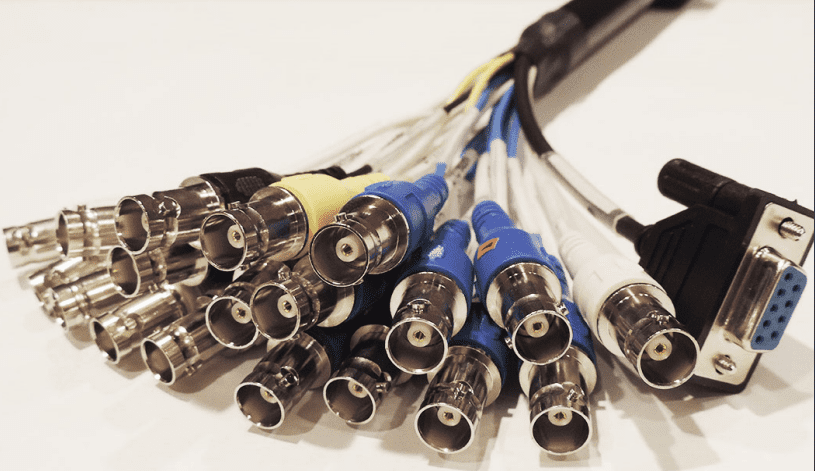In cables and wires, electromagnetic interference (EMI) can negatively affect the consistency and purity of signal transmissions, which, in turn, disrupts the performance of the devices and systems in which they are installed. For this reason, shielding is often integrated into cable and wire assemblies to protect them from EMI. It is important the shielding used is the right type for the interference experienced in the application environment. Otherwise, it may not work effectively.
Below, we provide an overview of shielded cables, including what they are, the types available, and typical applications to help readers understand how to choose and use them properly.
What Are Shielded Cables?
Shielded cables have an outer jacket that is protective and conductive. It essentially generates a Faraday cage, which blocks out external electromagnetic signals, improving the clarity of the signal transmitted through the internal conductive elements.
The jacket component can be made from a variety of materials. However, each comes with challenges that can affect installation and maintenance. For example, thicker braided materials are difficult to handle due to their weight and decreased flexibility, while thinner materials like foils and tapes are susceptible to tearing. Knowing the limitations of materials helps industry professionals choose the one that is best suited for the application.
Types of Cable Shielding
EMI cable shielding comes in many variations, each of which is suitable for different applications. Three of the most commonly used types of shielding are:
- Braided shielding: This type of shielding features a woven mesh structure comprised of tinned or bare copper wires. Depending on the weave tightness, interference coverage ranges from 70–95%.
- Foil shielding: This type of shielding is also known as tape shielding. It is made of a thin layer of aluminum or copper material, which can be bonded to a carrier material for increased strength and durability. As it is designed to be wrapped completely around the cable or wire with overlap, it provides 100% coverage.
- Spiral shielding: This type of shielding is made by helically wrapping conductive material around the core. It is typically used on small to medium-sized cables and wires for better coverage.
When Should I Use Unshielded vs. Shielded Wires & Cables?
While unshielded cables and wires can cancel low-level EMI interference, they are not well suited to environments where large amounts of power are used or needed since these situations create high levels of EMI. They are appropriate for use in indoor equipment, small- to moderate-sized facilities, and controlled industrial environments.
Shielded Wire & Cables in Use
EMI is highly detrimental to the performance of electrical and electronic devices and systems. As a result, shielded wires and cables can benefit virtually any industry or industrial process that uses this type of equipment. Some examples of typical applications for these products include:
Data Centers 
Data centers generally house a large number of electronic devices. As such, they transmit many signals, which can lead to decreased equipment performance when interference occurs. That’s why integrating EMI shielding in cable and wire assemblies is important for these facilities.
Industrial and Manufacturing Factories
EMI poses a significant threat to industrial and manufacturing factory production if it is not properly addressed. Some consequences of using unshielded cable and wire assemblies include equipment downtime, measurement errors, errors in data communication, and more. By using shielded cables and wires, factory owners and managers can better protect their people and processes.
Medical Facilities
Many medical facilities have attempted to address EMI issues by banning the use of mobile devices within them. However, some are beginning to find alternative solutions. For example, properly shielding the cables and wires in equipment helps prevent the effect of EMI on their performance.
Military Sites
In the military industry, electronic devices and systems often serve critical functions. That’s why it is vital to implement measures that ensure their effective and safe operation. Cable and wire shielding is key to achieving this goal since it prevents the equipment from being affected by EMI. Typical technologies that use shielded wires and cables include missiles, portable communication systems, electronic warfare systems, ground vehicles, avionics, and more.
Offices
Shielded cables and wires are essential in offices that heavily use computers and other electrical/electronic equipment. If EMI is not properly addressed, it can significantly affect the performance of equipment and, consequently, the productivity of office workers.
Learn More About Shielded Cables From Consolidated Electronic Wire & Cable
Shielded cable and wire assembly play a vital role in many industries and applications. To learn more about these products, contact the experts at Consolidated Electronic Wire & Cable. Equipped with over 100 years of experience in the design and manufacture of wire and cable solutions, we can answer any questions you may have about them. Additionally, if you need a wire and cable partner for your next project, we’ve got you covered. We have what it takes to deliver a custom shielding solution that meets your application requirements. Check out our custom cable guide to get started on your solution.




 () Quote Cart
() Quote Cart





Comments are closed